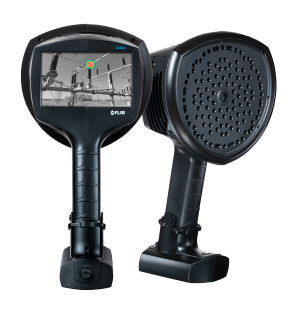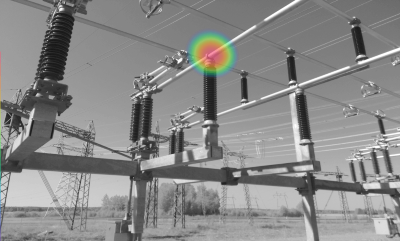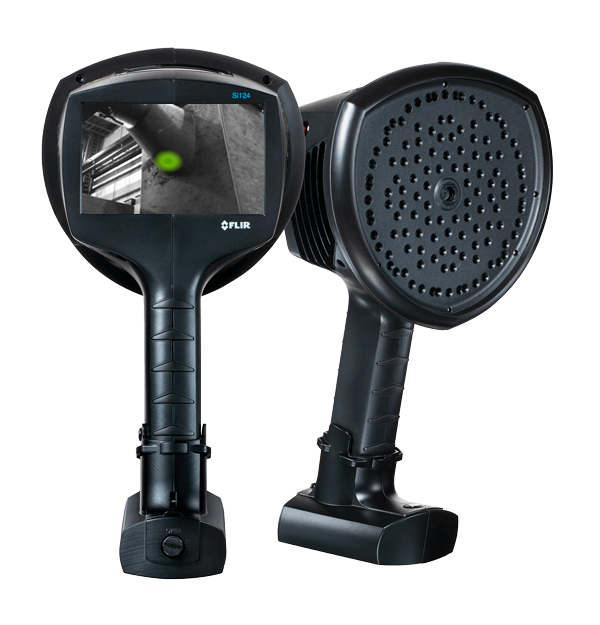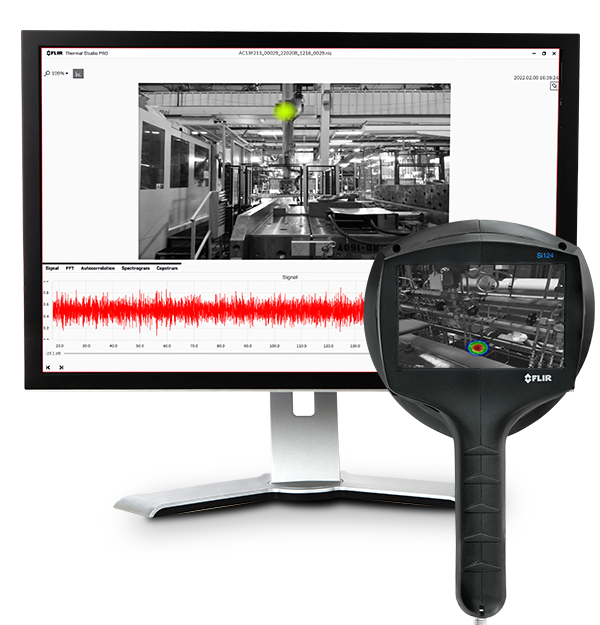Want to learn about the new FLIR Si2 Acoustic Cameras?

Condition Monitoring with a FLIR Si-Series Acoustic Imager
![]()
FLIR Si-Series Acoustic Imaging Cameras
Compressed air leaks, vacuum system leaks, electrical partial discharge—these are all expensive system issues that consume power, causing you to deal with unforeseen costs and potential production/uptime issues. Ultrasound imaging with an acoustic camera is an effective way to detect these equipment issues as part of a complete asset management plan. The FLIR Si124 is your perfect solution for locating pressurized leaks in compressed air systems and partial discharge problems in high-voltage electrical systems. This lightweight, one-handed camera can help you in utility, manufacturing, and engineering applications to identify efficiency loss and potential failures up to 10 times faster than traditional methods — with minimal training.
Calculate the Si124's ROI Request Demo
![]()


Detect partial discharge
Partial discharge (PD) indicates partial failure of an electrical insulator (can be a mechanical insulator, air gap, vacuum, liquid, etc). The Si124 and Si124-PD models use artificial intelligence to classify the specific type of partial discharge so you know exactly what to fix: surface discharge (typical with insulators, bushings, terminations), floating discharge (between components), and corona.

Compressed air leak detection
Finding the source of an air leak can be difficult and time-consuming with most tools, but our intelligent ultrasonic imaging system can make it quick and easy. The FLIR Si124 and Si124-LD cameras provide leak rates and cost estimations at safe distances to help with leak detection and prioritize repairs to improve safety and save money.
![]()
Why Choose a FLIR Acoustic Imager?
Effortless one-hand operation
You can keep one hand free while inspecting components for operator safety and to reduce neck strain.
Superior sound detection with 124 microphones
Si124 cameras have 124 microphones, which can help you pick up very quiet noises from a long distance for ultrasonic imaging. This is especially important when inspecting high-voltage systems and their potential leaks, which require a safe distance from the energized equipment. The force of a sound signal drops significantly as you move farther away from its source. The solution is to increase the number of microphones: quadrupling the number of microphones essentially doubles the sound detection range.
Optimal microphone performance
They use optimized dynamic range to balance frequency capabilities with how far sound travels. You want to use the lowest frequencies possible to get the farthest distance.
Machine learning capabilities
FLIR Si124 uses machine learning to distinguish the other characteristics of the sound pattern created by leaks and PD from the background. It is the same way you distinguish between a harmonica and a bell playing the same note. Due to the large number of sensitive microphones combined with modern computer processing using machine learning, we are able to distinguish between the background noise and the defect-created noise due to properties other than frequency.
Calculate Your Return on Investment
See How it Works

Want to learn about the new FLIR Si2 Acoustic Cameras?
Choose the Right Si124 Model for You
- Integrated Battery (no cords)
- Frequency Range: 2 kHz to 65 KHz
- Hard case and neck strap included
- Tethered battery & accessories available as additional options
- Free online software for analysis and reporting
- Compatible with FLIR Thermal Studio offline analysis and reporting software (free and paid versions available)
Si124
Can perform detection of partial discharge and leaks in small compressed air, gas, and vacuum systems.

Si124-LD Plus
Choose the Si124-LD Plus to detect even smaller compressed air, gas, and vacuum leaks. Provides the highest sensitivity as well as Auto Filtering and Auto Distancing features.
![]()
What To Look For In An Acoustic Imager
Effective Frequency Range
One of the first features to consider is the camera's frequency range. You might think that you need the widest range possible in order to pick up the widest range of sounds. However, in reality, the most effective frequency range for compressed air leak detection is between 20 and 30 kHz. This is because using the 20 to 30 kHz range aids in distinguishing compressed air leaks from the background noise in a factory.
Optimal Number of Microphones
In the pursuit of quieter noises, more is better. Acoustic imaging cameras typically employ dozens of micro-electric-mechanical system (MEMS) microphones to collect and characterize sound. While MEMS are small, use little power, and are very stable, they also generate their own noise that interferes with an individual microphone's ability to pick up very quiet sounds. The solution is to increase the number of microphones in use; simply doubling the number of microphones improves the signal-to-noise ratio enough to remove three decibels of unwanted sounds.
Si124 is now Compatible with FLIR Thermal Studio
The FLIR Si-Series Plugin for FLIR Thermal Studio allows you to import acoustic images from FLIR Si-Series acoustic imagers to FLIR Thermal Studio. Easily edit and analyze images, and create advanced reports. With the plugin, you have support for automatic fault classification, severity indication, recommended action for utility inspections, estimation of leak volume, and cost savings for air leaks. Combine acoustic images with thermal imaging in the same report.
FREQUENTLY ASKED QUESTIONS
Are the existing part numbers of Si124 acoustic imagers still available?
Yes, existing Si124 35 kHz models can be ordered until around the end of 2022.
Can I still get the tethered battery for my camera?
Yes, the tethered battery is available for the new camera models as an accessory option. To use the tethered battery with the new models, a Torx screwdriver is used to remove the integrated battery attachment, and the tethered battery plugs into the base of the unit.
Can I get the non-tethered battery system for my existing Si124?
We will introduce an accessory kit later this year to enable existing Si124 camera users to use the new battery system.
What does the change to frequency range provide?
Old ultrasound technology relied on frequency tuning to distinguish among different defects. This resulted in inspection standards requiring ultrasonic sensors to respond to frequencies higher than 35 kHz. Despite advances in technology, these standards still influence purchasing habits. The higher the frequency, the less distance the wave will travel, so users may not notice any performance difference between the new and existing camera models unless working at very close distances to targets. The latest version can operate in ULTR mode (30-65 kHz) which is effective for finding very small leaks at short distances. This high-frequency operation is not as effective for long-distance detection due to sound absorption by the air over long distances.



